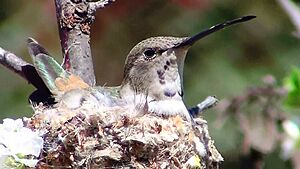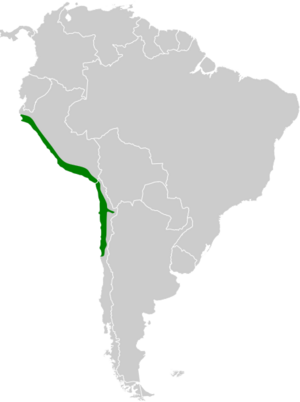Oasis hummingbird facts for kids
Quick facts for kids Oasis hummingbird |
|
|---|---|
 |
|
| Conservation status | |
| Scientific classification | |
| Genus: |
Rhodopis
|
| Species: |
vesper
|
 |
|
| In green, The distribution of this species. | |
The oasis hummingbird (Rhodopis vesper) is a special kind of hummingbird. It's part of a group called "bee hummingbirds" because they are so tiny! This bird is the only species in its genus called Rhodopis. You can find the oasis hummingbird living in Chile and Peru.
Contents
About the Oasis Hummingbird
The oasis hummingbird has three main types, also known as subspecies. These are R. v. vesper, R. v. koepckeae, and R. v. atacamensis. For a while, R. v. atacamensis was thought to be a completely different species. But scientists later decided it was just another type of oasis hummingbird.
What Does It Look Like?
The oasis hummingbird is about 11 to 13.5 centimeters (4 to 5 inches) long. It weighs around 4 grams (0.14 ounces), which is super light! Both male and female birds have a long, black, curved beak.
The main type, R. v. vesper, is a bit bigger. It also has a longer and stronger beak than the other two types. But otherwise, all three types look quite similar.
Both male and female birds have olive green feathers on their backs. Their lower back and tail feathers are a warm cinnamon color. Females have a small white dot behind their eye. Males have a longer white stripe there.
Male oasis hummingbirds have a super shiny throat patch called a gorget. This patch can be rosy violet or purple. It also has a bit of turquoise at the back. Their bellies are dull white, with a dull green color on their sides. Their tail is deeply split, like a fork. The middle feathers are grayish olive, and the rest are purplish brown.
Female birds do not have the colorful gorget. Their bellies are pale gray or light tan, with darker sides. Their tail is shorter than the male's and only slightly split. The top of their tail is olive green or bronzy green. All but the middle pair of tail feathers have a wide black stripe near the end and white tips.
Where Do They Live?
The R. v. koepckeae subspecies of the oasis hummingbird has only been found in one place. That place is in northwestern Peru's Department of Piura.
The main type, R. v. vesper, lives just south of there. You can find it throughout Peru and into Chile's Tarapacá Region. The R. v. atacamensis subspecies lives even further south in Chile. It can be found between the Atacama and Santiago Metropolitan areas. These birds have spread further south in Chile since the 1960s.
Oasis hummingbirds live in many different places near the coast. These include dry scrublands with green oases, areas along rivers, farms, and even gardens. They can live from sea level up to 3,800 meters (12,500 feet) high. But in most of Peru, they usually live below 2,600 meters (8,500 feet).
How They Behave
Movement and Travel
Oasis hummingbirds are not known to travel long distances or migrate. But they have moved into lonely oases and valleys. This means they must explore and fly around a bit. They might also move to different heights depending on the season.
What They Eat
The oasis hummingbird finds nectar from flowers at all different heights. They also eat small arthropods, which are like tiny insects or spiders. We don't know all the details about what else they eat.
Reproduction and Life Cycle
Male oasis hummingbirds like to protect their space, especially from other hummingbirds. They do special dances to attract females.
In one dance, they hover about 10 to 15 centimeters (4 to 6 inches) in front of a female. They sing, show off their bright gorget, and move up, down, left, and right. They also spread their tail feathers and wave them side to side. This is all to impress a possible mate!
When they fly normally, their wings beat very fast and steadily. But during their special dance, males can stop flapping for a tiny moment. This makes them drop slightly before they start flapping again. It looks like they are bouncing in place! They also do a dive display. They fly high into the air and then swoop down past the females. As they do this, their tail feathers make a sharp whistling sound.
We don't know much else about how oasis hummingbirds raise their young. They might nest all year long. But in Chile, nests with eggs have only been seen between September and December.
Their nest is shaped like a cup and hangs from a tree or bush branch. They usually lay two eggs. In studies, female birds took about 16 days to hatch the eggs. The young birds were ready to fly about 27 days after hatching.
Their Sounds
Scientists haven't recorded many of the oasis hummingbird's sounds. What seems to be their song is "tzee-tzee-dee-dee". It starts high and then goes lower.
Their calls include a "pretty series of tick and tzee notes." These notes can be fast or slow, and their tone can change. They also make a "rapid, thin, liquid chatter" and a rich "chew note."
Their Status in the Wild
The IUCN (International Union for Conservation of Nature) has looked at the oasis hummingbird. They say it is a species of "Least Concern." This means it is not currently in danger of disappearing.
The bird lives in a very large area. Even though we don't know exactly how many there are, their numbers seem to be steady. People have lived in their habitat for thousands of years. So, it seems that human activities don't affect the oasis hummingbird much, at least for now.


